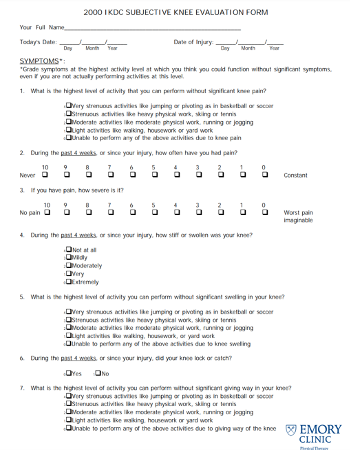Ardern, C. L., Taylor, N. F., Feller, J. A., & Webster, K. E. (2014). Fifty-five per cent return to competitive sport following anterior cruciate ligament reconstruction surgery: an updated systematic review and meta-analysis including aspects of physical functioning and contextual factors. British Journal of Sports Medicine. Nov2014, 48(21), 1543. doi:10.1136/ bjsports-2013-093398
Ardern, C. L., Taylor, N. F., Feller, J. A., Whitehead, T. S., & Webster, K. E. (2015). Sports Participation 2 Years After Anterior Cruciate Ligament Reconstruction in Athletes Who Had Not Returned to Sport at 1 Year: A Prospective Follow-up of Physical Function and Psychological Factors in 122 Athletes. American Journal of Sports Medicine (AM J SPORTS MED), Apr2015. doi:http://0-dx.doi.org.catalog.llu.edu/10.1177/0363546514563282
Ardern, C. L., Osterberg, A., Tagesson, S., Gauffin, H., Webster, K. E., Kvist, J., & Österberg, A. (2014). The impact of psychological readiness to return to sport and recreational activities after anterior cruciate ligament reconstruction. British Journal of Sports Medicine (BR J SPORTS MED), Dec2014. doi:http://0-dx.doi.org.catalog.llu.edu/10.1136/ bjsports-2014-093842
Ardern CL, Webster KE, Taylor NF, Feller JA. Return to sport following anterior cruciate ligament reconstruction surgery: A systematic review and meta-analysis of the state of play. Br J Sports Med 2011;45(7):596-606.
Arden CL, Taylor NF, Feller JA, Whitehead TS, Webster KE. Psychological Responses Matter in Returning to Preinjury Level of Sport After Anterior Cruciate Ligament Reconstruction Surgery. The American Journal of Sports Medicine. 2013; 41 (7): 1549-1558. Doi:10.1177/0363546513489284.
Chmielewski TL, Zeppieri G Jr, Lentz TA, et al. Longitudinal changes in psychosocial factors and their association with knee pain and function after anterior cruciate ligament reconstruction. Phys Ther 2011; 91: 1355–1366.
Everhart, J. S., Best, T. M., & Flanigan, D. C. (2015). Psychological predictors of anterior cruciate ligament reconstruction outcomes: a systematic review. Knee Surgery, Sports Traumatology, Arthroscopy (KNEE SURG SPORTS TRAUMATOL ARTHROSC), Mar2015. doi:http://0-dx.doi.org.catalog.llu.edu/10.1007/s00167-013-2699-1
Flanigan, D. C., Everhart, J. S., Pedroza, A., Smith, T., & Kaeding, C. C. (2013). Fear of reinjury (kinesiophobia) and persistent knee symptoms are common factors for lack of return to sport after anterior cruciate ligament reconstruction. Arthroscopy: The Journal of Arthroscopy & Related Surgery (ARTHROSCOPY), Aug2013. doi:http://0- dx.doi.org.catalog.llu.edu/10.1016/j.arthro.2013.05.015
Forsdyke D, Smith A, Jones M, et al. Psychosocial factors associated with outcomes of sports injury rehabilitation in competitive athletes: a mixed studies systematic review. Br J Sports Med 2016;50:537-544.
Lentz, T. A., Zeppieri, G., George, S. Z., Tillman, S. M., Moser, M. W., Farmer, K. W., & Chmielewski, T. L. (2015). Comparison of Physical Impairment, Functional, and Psychosocial Measures Based on Fear of Reinjury/Lack of Confidence and Return-to-Sport Status After ACL Reconstruction. American Journal of Sports Medicine (AM J SPORTS MED), Feb2015. doi:http://0-dx.doi.org.catalog.llu.edu/10.1177/0363546514559707
Te Wierike, et al. Psychosocial factors influencing the recovery of athletes with anterior cruciate ligament injury: A systematic review. Scandinavian Journal of Medicine & Science in Sports 2013.
Thomee P, Wahrborg P, Borjesson M, et al. Self-efficacy of knee function as a pre- operative predictor of outcome 1 year after anterior cruciate ligament reconstruction. Knee Surg Sports Traumatol Arthrosc 2008; 16: 118–127.
Tjong VK, Murnaghan ML, Nyhof-Young JM, et al. A qualitative investigation of the decision to return to sport after anterior cruciate ligament reconstruction: to play or not to play. Am J Sports Med 2014; 42: 336–342.
Tripp DA, Stanish W, Ebel-Lam A, et al. Fear of reinjury, negative affect, and catastrophizing predicting return to sport in recreational athletes with anterior cruciate liga- ment injuries at 1 year postsurgery. Rehabil Psychol 2007; 52: 74–81.
Wright RW, Haas AK, Anderson J, et al. Anterior cruciate ligament reconstruction rehabilitation: MOON guidelines. Sports Health 2015; 7: 239–243








